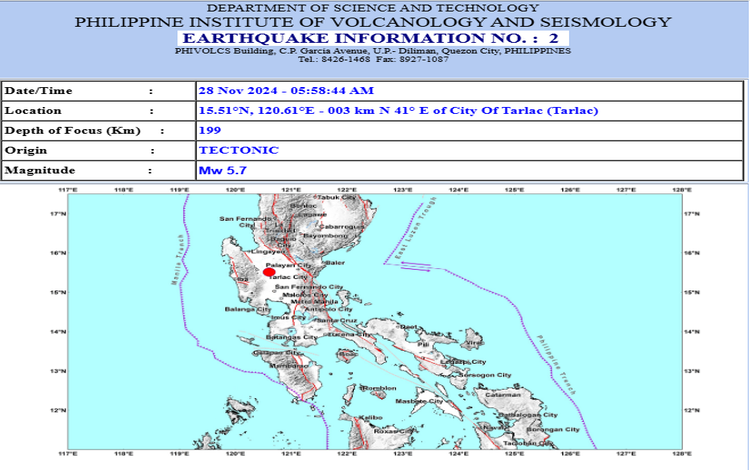A magnitude 5.7 earthquake was recorded northeast of Tarlac City early Thursday morning, according to the Philippine Institute of Volcanology and Seismology (PHIVOLCS).

The tremor occurred at 5:58 a.m. and was determined to be tectonic in origin, with a depth of 199 kilometers. This type of quake is caused by the movement of the Earth’s crust due to tectonic plate activity.
PHIVOLCS initially reported the event as a magnitude 5.7 earthquake and later confirmed the details. The epicenter was located northeast of Tarlac City, but no significant damage to infrastructure or properties is expected due to the depth of the quake.
While the agency has not issued any alerts for widespread damage, it cautioned the public about possible aftershocks. These secondary tremors are common following seismic events, though their intensity and frequency can vary.
Residents in areas near the epicenter reported light shaking but no major disruptions. Local authorities have been advised to monitor for updates and ensure preparedness for any potential aftershocks.
PHIVOLCS continues to monitor seismic activity in the region. The agency reminded the public to remain vigilant and adhere to earthquake preparedness measures, such as identifying safe spots in their homes and workplaces and ensuring emergency kits are readily available.
The Philippines, situated along the Pacific Ring of Fire, is highly prone to earthquakes and volcanic activity. Due to its proximity to major tectonic plate boundaries, the region experiences frequent seismic events.
Although there was no significant damage or casualties, Thursday’s quake reminded the country of its seismic vulnerability and the importance of preparedness. PHIVOLCS urged communities to participate in disaster response drills and maintain awareness of local hazard maps to understand risks in their areas better.
Authorities have assured the public that disaster response teams are on standby should the need arise. Updates regarding aftershocks or changes in seismic activity will be disseminated through official PHIVOLCS channels.
